Cabo Verde has been emerging as a top destination for birdwatching. With its prime location in the middle of the Atlantic, the archipelago offers unique habitats that host a wide variety of seabirds and land birds, including several endemic species.
A positive aspect worth highlighting is the strong emphasis on local ecosystem conservation in Cabo Verde. With significant support from various associations, the protection of species is prioritized, and sustainable tourism is encouraged to preserve biodiversity.
If you love nature and photography, Cabo Verde is your perfect destination!
Seabirds, land birds, and endemic species in Cabo Verde
The archipelago is home to a range of seabirds and land birds, some of which are endemic, attracting ecotourists from all over the world. Some of the species you can find in Cabo Verde include:
Red-billed Tropicbird - Rabo-de-Junco (Phaethon aethereus):
One of the most beautiful seabirds, the Red-billed Tropicbird displays graceful flight with its long tail, and its red beak stands out against mostly white plumage.
Between January and February, they nest on the islands of Santo Antão, São Vicente, São Nicolau, Sal, Boa Vista, Santiago, Fogo, and Brava, as well as on the Desertas islands and the islets of Rabo-de-Junco, Curral Velho, and Rombo.
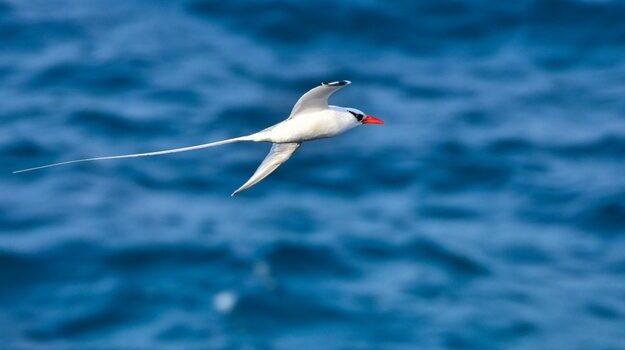 Red-billed Tropicbird - Rabo-de-junco | © Sergi Torné
Red-billed Tropicbird - Rabo-de-junco | © Sergi Torné
Via - Aves Marinhas de Cabo Verde
Fea's Petrel - Gongon (Pterodroma feae):
This vulnerable and endemic species nests between December and January in locations such as Santo Antão, São Nicolau, Santiago, and Fogo.
It can be identified by its dark grey plumage, white underbelly, and small black beak.
With its rapid flights, the Fea's Petrel only comes ashore to breed, making it a difficult bird to spot. However, its elusive nature makes it particularly fascinating for ornithologists.
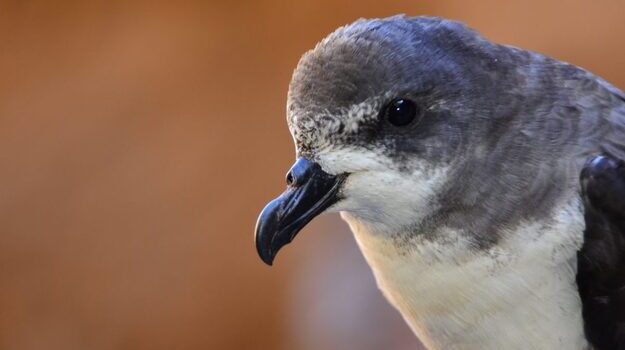 Fea's Petrel - Gongon | © Sergi Torné
Fea's Petrel - Gongon | © Sergi Torné
Via - Aves Marinhas de Cabo Verde
Cabo Verde Shearwater - Cagarra (Calonectris edwardsii):
This endemic bird can be identified by its white underbelly, which contrasts with its brownish-grey plumage.
The breeding period occurs throughout Cabo Verde, except on the islands of Maio and Santa Luzia, and also on the islets of Raso, Rabo-de-Junco, and Curral Velho.
Breeding begins in March, with chicks typically hatching between July and August.
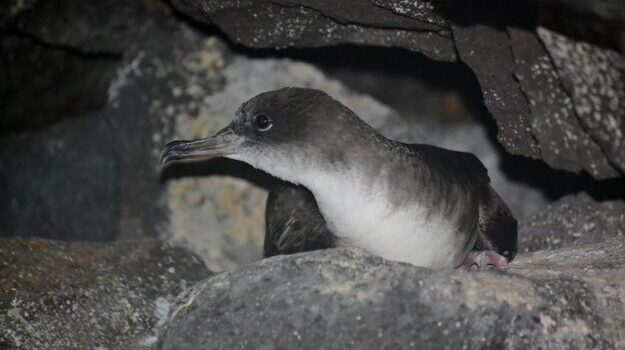 Cabo Verde Shearwater - Cagarra
Cabo Verde Shearwater - Cagarra
Source: Aves Marinhas de Cabo Verde
Boyd's Shearwater - Pedreiro (Puffinus lherminieri boydi):
With greyish-blue legs, dark plumage, and a white belly, the Boyd's Shearwater is one of the most well-known seabirds in Cabo Verde.
It nests between February and March on islands such as Brava, Fogo, São Nicolau, Santiago, Sal, and Santo Antão, as well as on the Desertas islands and the islets of Rombo and Rabo-de-Junco.
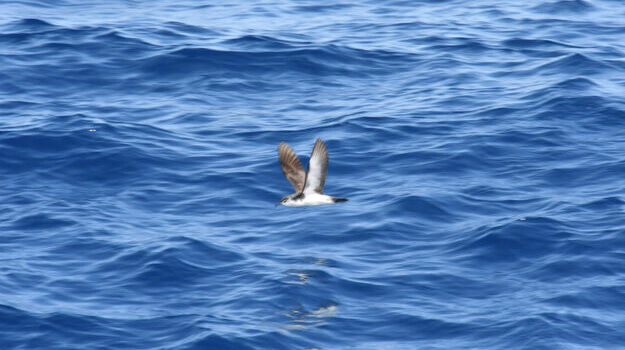 Boyd's Shearwater - Pedreiro em vôo | © Jacob González-Solís
Boyd's Shearwater - Pedreiro em vôo | © Jacob González-Solís
Via - Aves Marinhas de Cabo Verde
Brown Booby - Alcatraz (Sula leucogaster):
This seabird can be identified by its dark plumage contrasting with a white patch on its belly and its long yellow beak.
In Cabo Verde, the Brown Booby breeds between December and January on the islands of Santiago and Brava, as well as on the islets of Raso, Curral Velho, and Baluarte.
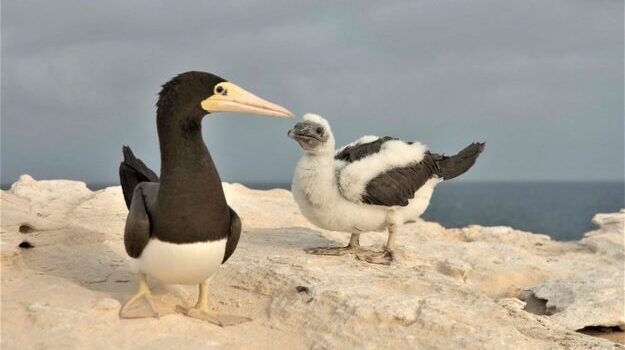 Brown Booby - Alcatraz | © Jacob González-Solís
Brown Booby - Alcatraz | © Jacob González-Solís
Via - Aves Marinhas de Cabo Verde
Fan-tailed Raven - João Preto (Corvus rhipidurus):
A small seabird with dark plumage, the Fan-tailed Raven is a symbol of Cape Verde’s wildlife. It nests between January and April on the islets of Raso, Rabo-de-Junco, and Rombo.
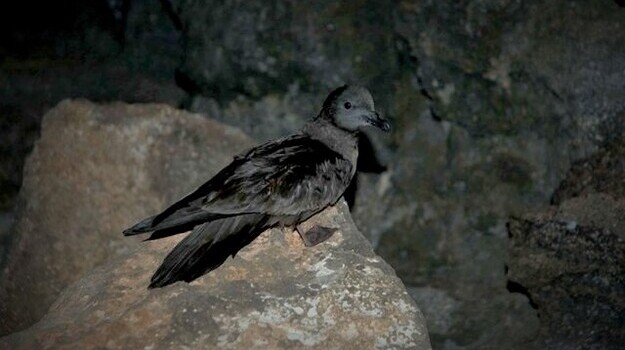 Fan-tailed Raven - João-Preto | © Jacob González-Solís
Fan-tailed Raven - João-Preto | © Jacob González-Solís
Via - Aves Marinhas de Cabo Verde
Egyptian vulture - Abutre-do-Egipto (Neophron percnopterus):
Also known as the "passarão," the Egyptian vulture is the smallest vulture in Europe and one of the most impressive land species in Cabo Verde, found on Santo Antão, Boa Vista, and Maio.
This bird is under threat but is closely monitored by local conservation projects. In 2021, a nest was discovered on Boa Vista Island during birdwatching efforts, marking a significant find for the species’ protection.
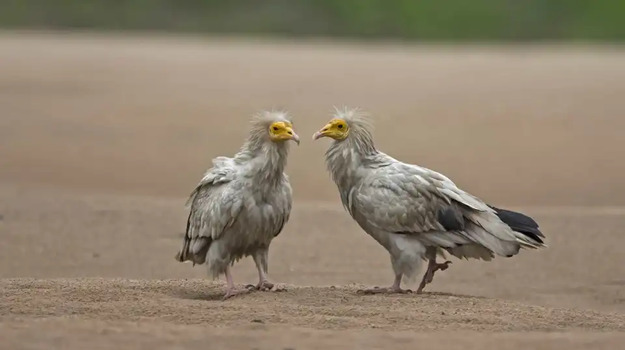 Egyptian vulture - Abutre-do-Egipto
Egyptian vulture - Abutre-do-Egipto
Source - Mundo ao Minuto
Cabo Verde is also an important stopover point for various migratory species, adding even more diversity to the birdwatching experience.
Local bird conservation projects
There are several local projects dedicated to bird conservation and the protection of natural habitats in Cabo Verde, while also encouraging sustainable tourism.
Projeto Vitó:
As part of the Cabo Verde Seabird Program, Projeto Vitó aims to ensure the viability of species such as the Fea's Petrel and the Boyd's Shearwater, managing threats and engaging local communities in their protection.
BIOS.CV:
BIOS.CV actively works on the conservation of birds like the Egyptian Vulture, the Red-billed Tropicbird, and the Osprey, in collaboration with both local and international projects. The involvement of the local population has been crucial to the long-term success of these initiatives.
Best practices for Birdwatching
Exploring Cape Verde’s rich birdlife can be a captivating experience. To make the most of this unique opportunity, here are a few tips:
Local guides as allies:
Rely on local guides who know the best birdwatching spots. They can help you discover some of the rarest species.
Respect for Nature:
Keep a safe distance to allow the birds to live undisturbed in their natural habitat.
Avoid touching or feeding them to ensure the preservation of their environment.
Experience Nature in Cabo Verde
Cabo Verde is truly a paradise for birdwatching, offering a unique mix of resident and migratory seabirds and land birds.
This makes the archipelago an unforgettable destination for ecotourists and photographers alike.
Responsible, sustainable tourism, along with the support of conservation projects like Projeto Vitó and BIOS.CV, has been key to Cape Verde's growing recognition as a premier birdwatching destination.
Plan your trip and pack your bags — Cape Verde’s birds are waiting for you.





